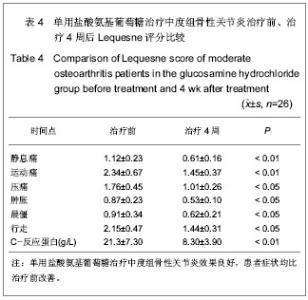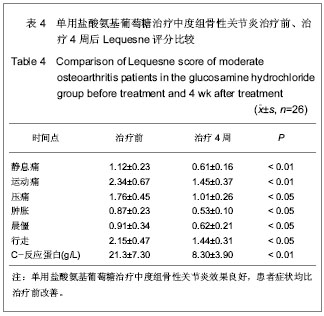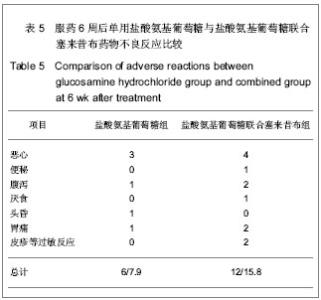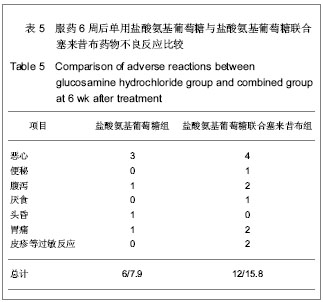Chinese Journal of Tissue Engineering Research
Glucosamine hydrochloride combined with celecoxib for the treatment of knee osteoarthritis: Randomized controlled trials
Li Ming-hui, Liu Yang, Wang Cai-min, You Hao, Huang Liang, Sun Kai
- Department of Orthopedics, Fifth Hospital of Wuhan (the Second Affiliated Hospital of Jianghan University), Wuhan 430050, Hubei Province, China
-
Received:2013-03-11Revised:2013-04-25Online:2013-10-22Published:2013-11-02 -
Contact:Liu Yang, Department of Orthopedics, Fifth Hospital of Wuhan (the Second Affiliated Hospital of Jianghan University), Wuhan 430050, Hubei Province, China liuyang19642000@163.com -
About author:Li Ming-hui★, Master, Attending physician, Department of Orthopedics, Fifth Hospital of Wuhan (the Second Affiliated Hospital of Jianghan University), Wuhan 430050, Hubei Province, China lmh061127@163.com
CLC Number:
Cite this article
Li Ming-hui, Liu Yang, Wang Cai-min, You Hao, Huang Liang, Sun Kai. Glucosamine hydrochloride combined with celecoxib for the treatment of knee osteoarthritis: Randomized controlled trials[J]. Chinese Journal of Tissue Engineering Research, doi: 10.3969/j.issn.2095-4344.2013.43.024.
share this article

2.1 参与者数量分析 按意向性分析,所有152例患者均完成试验,治疗后2,4,6周以及停药后8,12周随访,无中途退出或失访。 2.2 疗效分析 将轻、中、重组骨性关节炎分为单用氨基葡萄糖、联合用药2组,统计治疗2,4,6周及停药8,12周后Lequesne评分并与治疗前采用t 检验进行对比,同时将2组不同治疗时期Lequesne评分进行比较。 轻度骨性关节炎:盐酸氨基葡萄糖组用药4周后相对于治疗前评分显著降低,停药12周后的评分相对于治疗前差异仍存在显著性意义(P < 0.05);联合用药组服药2周后,评分开始降低,差异有显著性意义(P < 0.05),较盐酸氨基葡萄糖组起效快。见表1。"
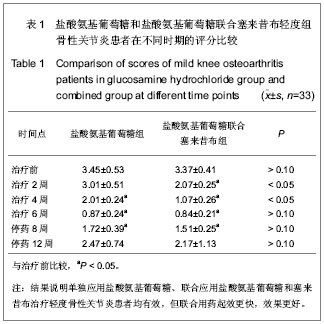

停药后,两组评分均有所增加,但仍低于治疗前。两组间比较,联合用药组在用药后2,4周与单用氨基葡萄糖组比较,差异有显著性意义(P < 0.05),但停药8,12周后2组比较,差异无显著性意义。 中度骨性关节炎:单独使用盐酸氨基葡萄糖4周后,lequesne评分开始降低,与治疗前比较,差异有显著性意义(P < 0.05,P < 0.01),停药后8周差异仍有显著性意义,但停药12周后与治疗前比较,差异无显著性意义;联合用药组服药2周后评分即显著降低,但同样停药12周后两组评分比较,差异无显著性意义。两组间比较,联合用药组在用药后2,4,6周与停药后8周比较,差异有显著性意义,停药12周后两组评分比较,差异无显著性意义。见表2。"
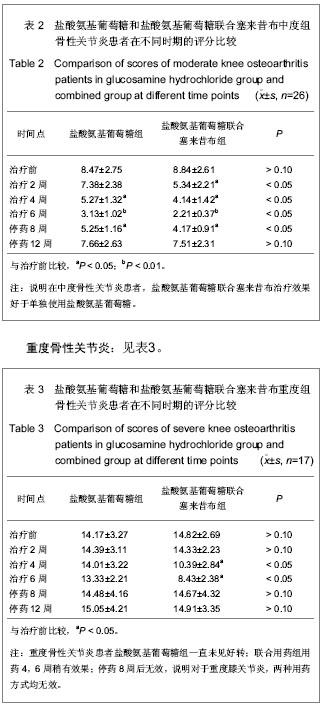
| [1] Lequesne M. Indices of severity and disease activity for osteoarthritis. Semin Arthritis Rheum. 1991;20(6 Suppl 2): 48-54. [2] Petersson IF, Boegard T, Saxne T, et al. Radiographic osteoarthritis of the knee classified by the Ahlbäck and Kellgren & Lawrence systems for the tibiofemoral joint in people aged 35-54 years with chronic knee pain. Ann Rheum Dis. 1997;56(8):493-496. [3] Li X, Ellman M, Muddasani P, et al. Prostaglandin E2 and its cognate EP receptors control human adult articular cartilage homeostasis and are linked to the pathophysiology of osteoarthritis. Arthritis Rheum. 2009;60(2):513-523. [4] Zhao SZ, Wentworth C, Burke TA, et al. Drug switching patterns among patients with rheumatoid arthritis and osteoarthritis using COX-2 specific inhibitors and non-specific NSAIDs. Pharmacoepidemiol Drug Saf. 2004; 13(5):277-287. [5] Verkleij SP, Luijsterburg PA, Bohnen AM, et al. NSAIDs vs acetaminophen in knee and hip osteoarthritis: a systematic review regarding heterogeneity influencing the outcomes. Osteoarthritis Cartilage. 2011;19(8):921-929. [6] Sawitzke AD, Shi H, Finco MF, et al. Clinical efficacy and safety of glucosamine, chondroitin sulphate, their combination, celecoxib or placebo taken to treat osteoarthritis of the knee: 2-year results from GAIT. Ann Rheum Dis. 2010;69(8):1459- 1464. [7] Durmus D, Alayli G, Bayrak IK, et al. Assessment of the effect of glucosamine sulfate and exercise on knee cartilage using magnetic resonance imaging in patients with knee osteoarthritis: a randomized controlled clinical trial.J Back Musculoskelet Rehabil. 2012;25(4):275-284. [8] Nakasone Y, Watabe K, Watanabe K, et al.Effect of a glucosamine-based combination supplement containing chondroitin sulfate and antioxidant micronutrients in subjects with symptomatic knee osteoarthritis: A pilot study.Exp Ther Med. 2011;2(5):893-899. [9] Reginster JY, Neuprez A, Lecart MP, et al.Role of glucosamine in the treatment for osteoarthritis. Rheumatol Int. 2012;32(10):2959-2967. [10] Kanzaki N, Saito K, Maeda A, et al.Effect of a dietary supplement containing glucosamine hydrochloride, chondroitin sulfate and quercetin glycosides on symptomatic knee osteoarthritis: a randomized, double-blind, placebo-controlled study.J Sci Food Agric. 2012;92(4):862- 869. [11] Kanzaki N, Saito K, Maeda A,et al.Effect of a dietary supplement containing glucosamine hydrochloride, chondroitin sulfate and quercetin glycosides on symptomatic knee osteoarthritis: a randomized, double-blind, placebo-controlled study. J Sci Food Agric. 2012;92(4):862- 869. [12] 陈德生,张志刚,曹靖.盐酸氨基葡萄糖对兔膝骨性关节炎的影响[J].中国修复重建外科杂志,2010,24(3):287-291. [13] Taniguchi S, Ryu J, Seki M, et al. Long-term oral administration of glucosemine or chondroitin sulfate reduces destruction of cartilage and up-regulation of MMP-3 mRNA in a model of spontaneous osteoarthritis in Hartley guinea pigs. J Orthop Res. 2012;30(5):673-678. [14] Altman RD. Glucosamine therapy for knee osteoarthritis: pharmacokinetic considerations.Expert Rev Clin Pharmacol. 2009;2(4):359-371. [15] Wang SX, Laverty S, Dumitriu M, et al. The effects of glucosamine hydrochloride on subchondral bone changes in an animal model of osteoarthritis. Arthritis Rheum. 2007;56(5): 1537-1548. [16] 王大利,耿成燕,姜丽平,等.关节软骨及骨破坏模型大鼠经盐酸氨基葡萄糖干预的最佳剂量[J].中国组织工程研究与临床康复, 2011, 15(28):5145-5148. [17] Lee YH, Woo JH, Choi SJ, et al. Effect of glucosamine or chondroitin sulfate on the osteoarthritis progression: a meta-analysis. Rheumatol Int. 2010;30(3):357-363. [18] Vangsness CT Jr, Spiker W, Erickson J. A review of evidence-based medicine for glucoSam-ine and chondroitin sulfate use in knee osteoarthritis. Arthroscopy. 2009;25(1): 86-94. [19] aniguchi S, Ryu J, Seki M, et al.Long-term oral administration of glucosamine or chondroitin sulfate reduces destruction of cartilage and up-regulation of MMP-3 mRNA in a model of spontaneous osteoarthritis in Hartley guinea pigs. J Orthop Res. 2012;30(5):673-678. [20] Matsuno H, Nakamura H, Katayama K, et al.Effects of an oral administration of glucosamine-chondroitin-quercetin glucoside on the synovial fluid properties in patients with osteoarthritis and rheumatoid arthritis. Biosci Biotechnol Biochem. 2009;73(2):288-292. [21] Meulyzer M, Vachon P, Beaudry F, et al.Comparison of pharmacokinetics of glucosamine and synovial fluid levels following administration of glucosamine sulphate or glucosamine hydrochloride. Osteoarthritis Cartilage. 2008; 16(9):973-979. [22] 皮俊杰,吕志伟,闫志荣,等.前交叉韧带切断诱导兔膝骨性关节炎模型:阿仑膦酸钠与盐酸氨基葡萄糖对其关节软骨和软骨下骨的保护作用[J].中国组织工程研究与临床康复,2010,15(28): 4702-4709. [23] 邱贵兴,翁习生,张克等.盐酸/硫酸氨基葡萄糖治疗骨关节炎的平行对照临床研究[J].中华医学杂志,2005,85(43):3067-3070. [24] 张伟滨,庄澄宇,李建民,等.盐酸氨基葡萄糖治疗骨性关节炎有效性与安全性评价[J].中华外科杂志,2007,45(14):998-1001. [25] Selvan T, Rajiah K, Nainar MS, et al.A clinical study on glucosamine sulfate versus combination of glucosamine sulfate and NSAIDs in mild to moderate knee osteoarthritis. ScientificWorldJournal. 2012,5(11):121-127. [26] Petersen SG, Beyer N, Hansen M, et al.Nonsteroidal anti-inflammatory drug or glucosamine reduced pain and improved muscle strength with resistance training in a randomized controlled trial of knee osteoarthritis patients. Arch Phys Med Rehabil. 2011;92(8):1185-1193. [27] Zupanets IA, Tuliakov VA, Shebeko SK. Effect of glucosamine hydrochloride in combination with paracetamol on chondrocyte apoptosis under conditions of systemic steroidal arthritis development in rats. Eksp Klin Farmakol. 2012; 75(4):34-37. [28] Yue J, Yang M, Yi S,et al.Chondroitin sulfate and/or glucosamine hydrochloride for Kashin-Beck disease: a cluster-randomized, placebo-controlled study. Osteoarthritis Cartilage. 2012;20(7):622-629. [29] 李春洁,贾源源,张绮,等.盐酸氨基葡萄糖片联合玻璃酸颞下颌关节骨关节炎的临床钠治疗随机对照试验[J].华西口腔医学杂志, 2011,9(6):632-639. [30] Rozendaal RM, Koes BW, van Osch GJ, et al. Effect of glucosamine sulfate on hip osteoarthritis: a randomized trial. Ann Intern Med. 2008;148(4):268-277. [31] Rozendaal RM, Uitterlinden EJ, van Osch GJ, et al. Effect of glucosamine sulphate on joint space narrowing, pain and function in patients with hip osteoarthritis; subgroup analyses of a randomized controlled trial. Osteoarthritis Cartilage. 2009;17(4):427-432. [32] Bruyere O, Pavelka K, Rovati LC, et al.Total joint replacement after glucosamine sulphate treatment in knee osteoarthritis: results of a mean 8-year observation of patients from two previous 3-year, randomized, placebo-controlled trials. Osteoarthritis Cartilage.2008;16(2):254-260. [33] Wilkens P, Scheel IB, Grundnes O, et al.Effect of glucosamine on pain-related disability in patients with chronic low back pain and degenerative lumbar osteoarthritis: a randomized controlled trial.JAMA. 2010;304(1):45-52. [34] 石锐,刘浩,胡韬,等.盐酸氨基葡萄糖联合非类固醇类抗炎药治疗小关节退变伴下腰痛[J].中国组织工程研究与临床康复,2011, 15(26):4895-4898. [35] 石锐,胡韬,丁琛,等.盐酸氨基葡萄糖联合低剂量NSAIDS类药物与单纯用药治疗小关节骨关节炎伴下腰痛的随机对照研究[J].中国骨与关节外科,2012,5(1):36-42. [36] Burdett N, McNeil JD. Difficulties with assessing the benefit of glucosamine sulphate as a treatment for osteoarthritis. Int J Evid Based Healthc. 2012;10(3):222-226. [37] Felson DT. Glucosamine sulfate might have no effect on pain or structural changes associated with osteoarthritis.Nat Clin Pract Rheumatol. 2008;4(10):518-519. [38] Sawitzke AD, Shi H, Finco MF, et al. Clinical efficacy and safety of glucosamine, chondroitin sulphate, their combination, celecoxib or placebo taken to treat osteoarthritis of the knee: 2-year results from GAIT. Ann Rheum Dis. 2010;69(8):1459- 1464. [39] Burdett N, McNeil JD. Difficulties with assessing the benefit of glucosamine sulphate as a treatment for osteoarthritis. Int J Evid Based Healthc. 2012;10(3):222-226. [40] Henrotin Y, Mobasheri A, Marty M. Is there any scientific evidence for the use of glucosamine in the management of human osteoarthritis?Arthritis Res Ther. 2012;14(1):201. [41] Chisholm T. Glucosamine for osteoarthritis. Select carefully for best results. Adv NPs PAs. 2011;2(4):25-26. [42] Muniyappa R.Glucosamine and osteoarthritis: time to quit? Diabetes Metab Res Rev. 2011;27(3):233-234. [43] McKenzie BA.What is the evidence? There is only very weak clinical trial evidence to support the use of glucosamine and chondroitin supplements for osteoarthritis in dogs. J Am Vet Med Assoc. 2010;237(12):1382-1133. [44] Bruyère O. Large review finds no clinically important effect of glucosamine or chondroitin on pain in people with osteoarthritis of the knee or hip but results are questionable and likely due to heterogeneity. Evid Based Med. 2011;16(2): 52-53. [45] Scholtissen S, Bruyère O, Neuprez A, et al. Glucosamine sulphate in the treatment of knee osteoarthritis: cost-effectiveness comparison with paracetamol. Int J Clin Pract. 2010;64(6):756-762. [46] Hart L. Are glucosamine and/or chondroitin sulfate effective for knee osteoarthritis?Clin J Sport Med. 2006;16(6):528-529. [47] 冮相保,高李侠.盐酸氨基葡萄糖治疗膝退行性骨性关节炎的临床观察[J].中国修复重建外科杂志,2008,22(1):29-31. |
| [1] | Zhang Jichao, Dong Yuefu, Mou Zhifang, Zhang Zhen, Li Bingyan, Xu Xiangjun, Li Jiayi, Ren Meng, Dong Wanpeng. Finite element analysis of biomechanical changes in the osteoarthritis knee joint in different gait flexion angles [J]. Chinese Journal of Tissue Engineering Research, 2022, 26(9): 1357-1361. |
| [2] | Jin Tao, Liu Lin, Zhu Xiaoyan, Shi Yucong, Niu Jianxiong, Zhang Tongtong, Wu Shujin, Yang Qingshan. Osteoarthritis and mitochondrial abnormalities [J]. Chinese Journal of Tissue Engineering Research, 2022, 26(9): 1452-1458. |
| [3] | Wang Baojuan, Zheng Shuguang, Zhang Qi, Li Tianyang. Miao medicine fumigation can delay extracellular matrix destruction in a rabbit model of knee osteoarthritis [J]. Chinese Journal of Tissue Engineering Research, 2022, 26(8): 1180-1186. |
| [4] | Liu Dongcheng, Zhao Jijun, Zhou Zihong, Wu Zhaofeng, Yu Yinghao, Chen Yuhao, Feng Dehong. Comparison of different reference methods for force line correction in open wedge high tibial osteotomy [J]. Chinese Journal of Tissue Engineering Research, 2022, 26(6): 827-831. |
| [5] | Zhou Jianguo, Liu Shiwei, Yuan Changhong, Bi Shengrong, Yang Guoping, Hu Weiquan, Liu Hui, Qian Rui. Total knee arthroplasty with posterior cruciate ligament retaining prosthesis in the treatment of knee osteoarthritis with knee valgus deformity [J]. Chinese Journal of Tissue Engineering Research, 2022, 26(6): 892-897. |
| [6] | Xu Lei, Han Xiaoqiang, Zhang Jintao, Sun Haibiao. Hyaluronic acid around articular chondrocytes: production, transformation and function characteristics [J]. Chinese Journal of Tissue Engineering Research, 2022, 26(5): 768-773. |
| [7] | He Junjun, Huang Zeling, Hong Zhenqiang. Interventional effect of Yanghe Decoction on synovial inflammation in a rabbit model of early knee osteoarthritis [J]. Chinese Journal of Tissue Engineering Research, 2022, 26(5): 694-699. |
| [8] | Lin Xuchen, Zhu Hainian, Wang Zengshun, Qi Tengmin, Liu Limin, Suonan Angxiu. Effect of xanthohumol on inflammatory factors and articular cartilage in a mouse mode of osteoarthritis [J]. Chinese Journal of Tissue Engineering Research, 2022, 26(5): 676-681. |
| [9] | Zhang Tong, Cai Jinchi, Yuan Zhifa, Zhao Haiyan, Han Xingwen, Wang Wenji. Hyaluronic acid-based composite hydrogel in cartilage injury caused by osteoarthritis: application and mechanism [J]. Chinese Journal of Tissue Engineering Research, 2022, 26(4): 617-625. |
| [10] | Zhang Jian, Lin Jianping, Zhou Gang, Fang Yehan, Wang Benchao, Wu Yongchang. Semi-quantitative MRI evaluation of cartilage degeneration in early knee osteoarthritis [J]. Chinese Journal of Tissue Engineering Research, 2022, 26(3): 425-429. |
| [11] | Wang Chong, Zhang Meiying, Zhou Jian, Lao Kecheng. Early gait changes after total hip arthroplasty through direct anterior approach and posterolateral approach [J]. Chinese Journal of Tissue Engineering Research, 2022, 26(3): 359-364. |
| [12] | Liu Shaohua, Zhou Guanming, Chen Xicong, Xiao Keming, Cai Jian, Liu Xiaofang. Changes in kinematic parameters after unicompartmental knee arthroplasty and high tibial osteotomy [J]. Chinese Journal of Tissue Engineering Research, 2022, 26(3): 390-396. |
| [13] | Guan Hong, Zhang Hongbo, Shao Yan, Guo Dong, Zhang Haiyan, Cai Daozhang. PDZ domain containing 1 deficiency promotes chondrocyte senescence in osteoarthritis [J]. Chinese Journal of Tissue Engineering Research, 2022, 26(2): 182-189. |
| [14] | Li Anan, Jiang Tao, Zhan Min, Cai Yuning, Song Min, Li Congcong, Lin Wenzheng, Zhang Jiayuan, Liu Wengang. Pharmacological mechanism of Shenling Baizhu San in the treatment of knee osteoarthritis based on network pharmacology and molecular docking [J]. Chinese Journal of Tissue Engineering Research, 2022, 26(2): 197-204. |
| [15] | Zhang Lei, Xiu Chunmei, Ni Li, Chen Jianquan. Identification and expression analysis of mouse nucleus pulposus specific markers [J]. Chinese Journal of Tissue Engineering Research, 2022, 26(11): 1669-1674. |
| Viewed | ||||||
|
Full text |
|
|||||
|
Abstract |
|
|||||
